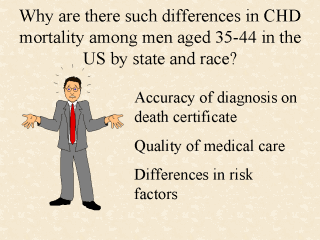Most of the
deaths from CHD in this age group are sudden and unexpected. Most of these sudden deaths,
at least for white men, are likely to be due to cardiovascular disease. We also evaluated
the death from diseases of heart (ICD 390-429) and found the similar results. There is
huge difficulty in validating death without careful autopsy evaluation. Traven et al.
evaluated the quality of cardiovascular mortality in Allegheny County, Pennsylvania for
the age group 35-44 from 1972 to 1992 (Ann Epidemiol 1996;6:130-136). There was reasonably
good agreement between the diagnoses based on the death certificate and after reviewers'
evaluation of the autopsy and medical information. Whether the accuracy is similar in
other areas of the US is unknown. Although emergency medical services have improved,
the number of out-of-hospital cardiac arrests that are still resuscitated and leave the
hospital, except in a few communities is still relatively small and therefore they are
unlikely to have a major effect on the mortality rates. Because most of the cardiovascular
deaths, probably at least 60-70%, occur out of the hospital in this 35-44 age group.
Differences in hospital treatment among the states probably have a relatively small effect
on the geographic variations in the mortality from CHD.
The most likely reason for the differences in the mortality from CHD by state and race
is due to variations in risk factor levels. Unfortunately, there is no direct method to
test this hypothesis.
